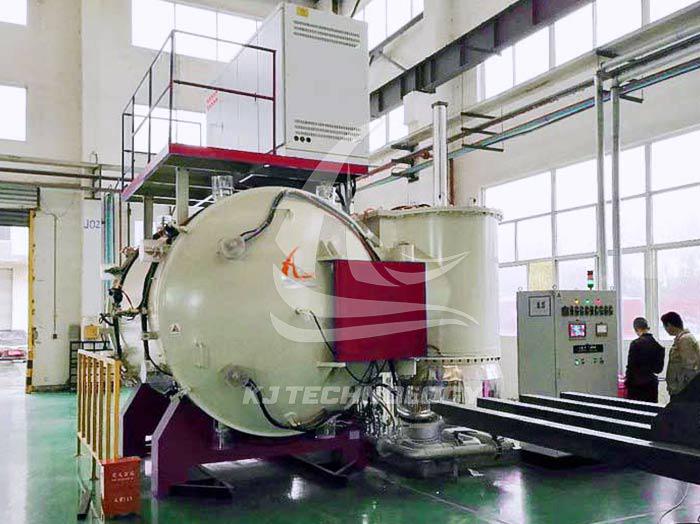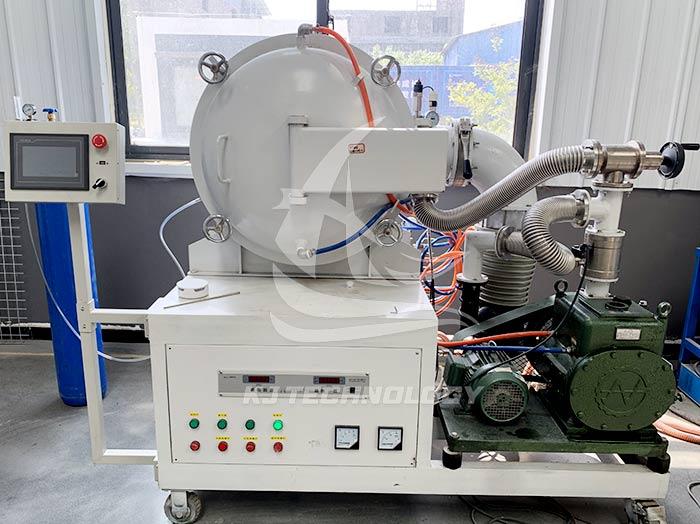Precautions for operating high vacuum heat treatment electric furnace
 09-26-2025 Author: KJ technology
09-26-2025 Author: KJ technology
When operating a high vacuum heat treatment electric furnace, it is necessary to strictly comply with safety regulations and process requirements. The following are key precautions:
1. Preparation before operation
Equipment inspection
Confirm that the electrical circuit is intact and reliably grounded to avoid the risk of electrical leakage.
Check whether the vacuum pump, vacuum gauge, heating element and other components are normal, and whether the vacuum pipeline is unobstructed.
Turn on the water cooling system, ensure that the cooling water circuit is unobstructed and the water temperature is moderate (the drainage temperature does not exceed 40-50 ℃), to prevent the sealing ring from aging or burning out.
Check the purity of the protective atmosphere system (such as nitrogen and argon) and replace the air in the buffer tank in advance.
Workpiece preparation
The materials to be processed need to be thoroughly cleaned and dried to prevent moisture and dirt from entering the furnace.
Remove burrs, rust spots, and dirt from the workpiece to avoid contaminating the furnace.
Reasonably design loading methods and fixtures to ensure uniform heating of the workpiece and control deformation.
Environmental Requirements
Ensure that there are no flammable or explosive materials around the equipment, keep the environment clean, and ensure smooth passage.
Operators need to wear labor protection equipment (such as protective gloves and goggles).
2. Standardized operation
Vacuum pumping and inflation
Connect the vacuum pump in a cold state and slowly evacuate to the maximum vacuum degree to avoid fuel injection.
When inflating, the furnace body is filled to atmospheric pressure through the intake valve before opening the furnace cover to prevent sudden exposure of the furnace and oxidation.
Ensure that the vacuum level meets the standard before heating to avoid surface oxidation of the workpiece.
Heating and cooling
Heating up: According to the process setting heating curve (maximum rate of 100 ℃/min), manual heating can be used below 200 ℃, and infrared automatic control is required above 200 ℃.
Cooling:
Do not cool rapidly when the temperature is above 400 ℃ to prevent thermal shock damage to the furnace body.
It is strictly prohibited to let water enter during the cooling process to avoid burning out the sealing ring.
Stop cooling water when the workpiece temperature drops below 200 ℃, and only when it drops below 150 ℃ can the furnace be inflated and opened.
parameter monitoring
Pay close attention to the temperature, vacuum degree, voltage, current and other instrument indications, and immediately cut off the heating power supply if any abnormalities are found.
Observe the working conditions inside the furnace. If there is arcing, local overheating, or three-phase current imbalance, adjust the parameters in a timely manner.
safe operation
Do not stand or operate under the lifted furnace cover or lid.
The lifting of the furnace cover must be carried out after inflation is completed to prevent danger caused by vacuum leakage.
In case of power outage, water outage or other emergencies, immediately activate the backup water supply system and turn off the heating power supply.
3. Post operation maintenance
Furnace cleaning
After the equipment cools down, clean the residue and impurities inside and around the furnace to maintain cleanliness.
Heat resistant steel components (such as base plates and heating elements) must be carefully cleaned of oxide scale and must not be struck.
Equipment Maintenance
Regularly inspect accessories such as vacuum pumps, valves, and instruments, clean the vacuum pumps, and replace heating elements.
Check the circulating water system to prevent mineral deposition and blockage. In winter, it is necessary to drain the water from the chiller and pipes to prevent freezing and cracking.
Regularly lubricate the mechanical transmission parts and replace vulnerable parts.
Long term discontinuation
Maintain the vacuum level inside the furnace after shutdown to prevent humid air from entering.
Cut off the power, turn off the gas and water sources, and take dust prevention measures.
4. Special process precautions
Controllable atmosphere heat treatment
When introducing or stopping the introduction of hydrogen, carbon monoxide, and other atmospheres, the furnace temperature should be maintained above 760 ℃ to ensure complete combustion of the gases.
When the process temperature is below 760 ℃, nitrogen gas needs to be introduced to drive away the air inside the furnace.
High-pressure gas quenching
When using high-purity nitrogen gas with a pressure of 5-6 bar for cooling, it is necessary to ensure a stable gas flow rate to avoid deformation of the workpiece.
After cooling, check the hardness and surface brightness of the workpiece to ensure the quenching effect.








